Cattle traffic
This used to be a lucrative traffic and here is a preliminary selection of worked-up illustrations, chronologically for developments over time had the greatest effect on the traffic, across the UK as a whole. There are five parts:
1 - Transitions and the balance over the years 2 - Early Big Four 3 - Later Big Four 4 - LMS-related - now a separate topic 5 - BR days
New addition placed here temporarily
No date and no location although it looks like an early spring day in the '50s on the 4-track in the Thames Valley as ex-GWR 2-6-0 No 9308 approaches with a goods carrying rather humble Class J lights. Photographer unknown, author's collection.
Click on the image for an enlargement
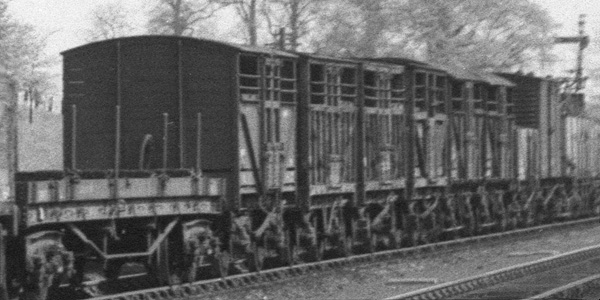
Half a dozen empty cattle trucks are being forwarded, 4 ex-LMS/LMR, 2 ex-GWR/WR. Moves like this were made a couple of days before one of the region's cattle markets, at Banbury, for example.
Click on the image for an enlargement
1 - Transitions and the balance over the years
A key transition, albeit a slow one at first, was from manually braked trucks to automatically vacuum braked (AVB) ones. Construction of the latter had started before the Grouping but in relatively small quantities and both types continued to be built afterwards. Indeed, until the BR era the manually braked cattle truck was the staple. Alas, they are usually impossible to tell between in train pictures!
Another slow transition lay in the continued use of cattle trucks from preceding eras. On the LNER, for example, in 1930 the LNER fleet of cattle trucks was 66% pre-Grouping and in 1939, still 50%.
By the early 1950s the pre-Grouping designs had been eliminated but Big Four designs continued to serve, bolstered by construction between 1949-50 of AVB batches set up by the GWR, LMS and SR. These additions totalled 2,800. The BR-proper design introduced in 1951 was based on the GWR's final one and it can be hard to tell apart; and only 1,300 were built. Small wonder that they are not seen very often in train pictures, even in the 1960s because the 1949-50 builds outnumbered them by 2:1.
If modelling the Big Four era before WWII, half of your cattle trucks should be of pre-Grouping origin and something like 2/3 manually braked. I don't think this is what most modellers imagine was the case! Fortunately, there are many kits for them. In BR days, once the pre-Grouping designs had been eliminated, around three-quarters of the cattle trucks had been built by the Big Four or to their designs as described above, and AVB became the norm. But the traffic was increasingly being lost to the roads, especially over short distances, and ended altogether in 1975 when BR ceased handling livestock.
2 - Early Big Four

Where there was sufficient traffic, Cattle Specials were worked to and from cattle markets and to slaughterhouses and this first picture is an example from 1908 with GER 0-6-0 No 537 in charge at Brentwood.
Note the use of limewash as a disinfectant (NOT "whitewash"). This lasted until around 1924 when liquid disinfectant was introduced. Use of lime in cattle trucks was banned formally a few years later but the liquid version (based on phenol, a.k.a. carbolic acid) was adopted quickly because it was so much better. Everybody was really glad to see the back of lime. Photo: Ken Nunn Collection.
Click on the image for an enlargement
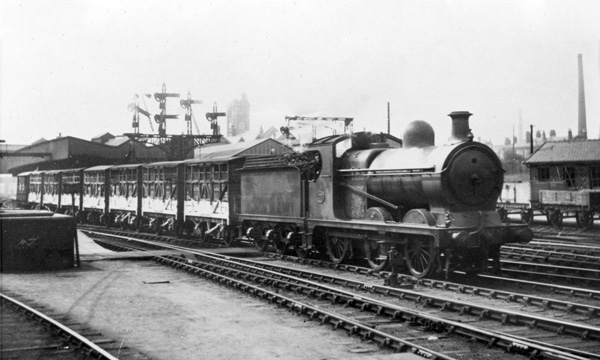
Another Cattle Special, this time passing through Guide Bridge behind an unidentified J11. It was normal for the cattle trucks to be provided by the railway company on whose metals the train started and here they are all GCR. Photo: Author's collection.
Click on the image for an enlargement

A classic view of a through goods at Tamworth c1922 behind LNWR 4-4-0 "Benbow" class No 1956 Illustrious. Behind the loco are three GER cattle trucks, apparently manually braked although they may have been through piped by now. Cattle trucks were often placed behind the loco whether loaded or empty. Photo: warwickshirerailways.com
Click on the image for an enlargement

This view from 1925 shows use of liquid disinfectant in a through freight behind J11 No 5219 heading south from Woodford and Hinton with cattle trucks, presumably loaded, placed behind the tender, which was the norm. Only two can be identified: ex-GER and GWR. Photo: Real Photographs.
Click on the image for an enlargement

A superb but alas undated picture by H. Gordon Tidey from the period when ex-GCR J10s operated in East Anglia shows No 5805 on a pick-up goods approaching Beccles (with thanks to Geoff Moore - previously miscaptioned "Yarmouth South Town" per the back of the original print, not in Gordon Tidey's hand). Beccles engine shed is in the background with the line from Lowestoft on the right and a glimpse of the substantial exchange yard for lines which met here. This J10 was at Norwich between 1926-30 with an undated blip at Yarmouth and was probably working between Norwich-Beccles, Norwich-Ipswich or Yarmouth South Town-Beccles.
A batch of seven empty cattle wagons has been included, all LNER and of pre-Grouping origin:
4 - ex-NER 2 - ex-NBR 1 - ex-GER
Note how far most of these trucks had originated from, and that most are of the "Medium" size. Manually braked trucks had been common user since the Great War and a possible explanation may be that they were being segregated for batch return to the North East or being forwarded empty for a cattle market working. There is also a possibility that these cattle wagons, now almost completely free of limewash, may have been roped in to carry a glut of some kind of vegetable.
It's interesting that wagons near the rear are carrying sugar beet which cropped from late summer (as seen here) but the nearest sugar factory was to the north at Cantley on the outskirts of Norwich. Another was at Ipswich. All told, there is much here that has yet to be explained!
Click on the image for an enlargement
3 - Later Big Four
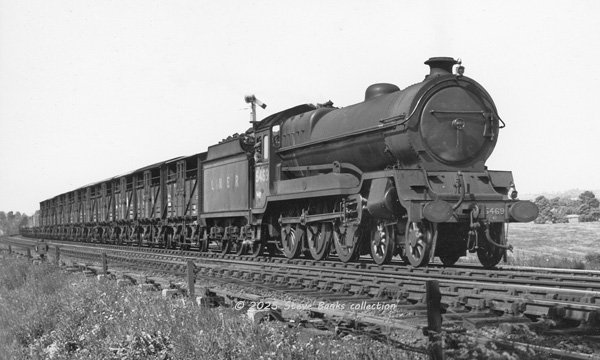
Revised caption
This picture has been dated as 1939 and 1946 and shows ex-GCR B7 No 5469 passing the laybye at Staverton Rd. (the signal box is behind the photographer) with an up Class A through goods for Woodford Halse. The correct date would have been 1939 when the loco was at Annesley (rather than 1949 when it was at Gorton). At the head of the train are 10 GWR cattle trucks probably being taken back to Banbury Cattle market. The wagon liveries are a mixture of the large and the later, smaller letter schemes. Although almost certainly empties, they had been placed behind the loco all the same. Photo: Gordon Coltas.
Click on the image for an enlargement

K3 No 2426 has a down fitted goods express near Marshmoor, one of which was nicknamed the "Scotch goods". Three cattle wagons have been placed near the front of the train.. This wasn't unusual for a working from London and as these trains only stopped at principal locations, the destination would have been relatively distant.

Most modellers would have expected LNER vehicles but, see for yourself, none of them are: they are LMS(2) and SR(1), either vac fitted or through piped. Just another illustration of how large a part other companies' wagons played. It may be fair to add that the LMS ones would have been painted grey and the SR one, brown - the kind of thing that doesn't show on b&w photographs.
It's unlikely that they would have been empty in such a train and I suspect that they were loaded and that the van behind the tender may have been a last minute addition. Photo: author's collection.
Click on the image for an enlargement
4 - LMS-related
Now a separate topic - see links below.
5 - BR days

It's July 1950 and B1 No 61002 Impala of St. Margaret's shed is at an unknown location with a Class 10 "pick up" goods train, almost certainly empties. The whole train cannot be seen as it passes under the bridge, but it's possible to count approximately 23 cattle trucks. The vast majority are to LMS designs, especially the heavily-braced ones whose construction started in the 1920s and continued with detail differences into WWII. The final version can be seen in the third wagon along, and many more like it further back, which had a simpler body, a steel underframe and steel angle diagonals. BR sanctioned its construction in 1949 to BR Dia 1/350, which was given B-prefix numbers. These two LMS designs, old and new, dominate this train. You have to go to the 10th wagon along to find something different, a GWR design; to the 13th for a SR design; and the 15th for an LNER design. Further back there are more LMS designs but the detail is increasingly blurred and hard to resolve. In short, the identifiable designs are approximately:
17 - LMS 1 - GWR 1 - SR 1 - LNER
For a further perspective on this clearly visible state of affairs, the 1949 build to the LMS-design ran to 1,350 vehicles which was twice as much as the LNER had built during the whole of the 1930s. BR Dia 1/351 comprised 150 wagons to a SR design, also built in 1949, followed by 1,300 in 1949-50 to Dia 1/352, which was based on a GWR design. This addition during 1949-50 of 2,800 new trucks to what was now the BR-owned fleet enabled old and unsatisfactory designs to be weeded out, especially the ex-LNER ones, which that company had been culling anyway. Photo: G.W. Sharpe.
Click on the image for an enlargement

This undated view from the mid-1950s somewhere in East Anglia shows E4 2-4-0 No 62788 (Norwich or Cambridge) with a pick-up goods of 18 wagons, the first ten of which are cattle wagons. As far as I can tell they are:
5 ex-GWR/BR 4 ex-LMS designs 1 ex-LNER 10ft WB
LNER/ER aficionados may note that only a few years after Nationalisation, only a single ex-LNER wagon (10%) was deployed and that its underframe is sagging. Photo: Real Photographs.
Click on the image for an enlargement

In this 1956 view at Pontypool Road, 2-6-0 No 6369 from Severn Tunnel Junction has what appears to be a load of cattle empties. They may have been returning from an abattoir or a positioning move for a weekly market. The mixture of types that can be identified includes one BR design - the rest (something like 90% of the train) originate from the Big Four companies: ex-LMS, ex-GWR, ex-LNER (one of which is visibly down at heel), and ex-SR. Photo: author's collection.
Click on the image for an enlargement
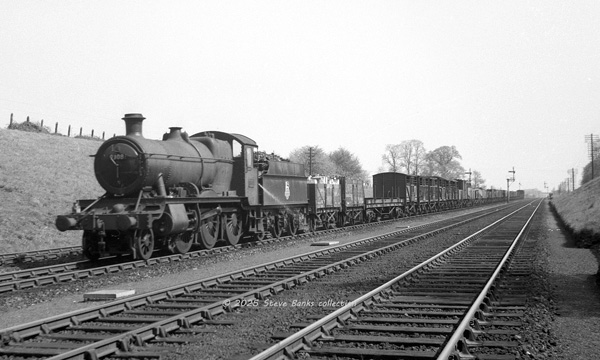
No date and no location although it looks like an early spring day in the '50s on the 4-track in the Thames Valley as ex-GWR 2-6-0 No 9308 approaches with a goods carrying rather humble Class J lights. Photographer unknown, author's collection.
Click on the image for an enlargement

Half a dozen empty cattle trucks are being forwarded, 4 ex-LMS/LMR, 2 ex-GWR/WR. Moves like this were made a couple of days before one of the region's cattle markets, at Banbury, for example.
Click on the image for an enlargement
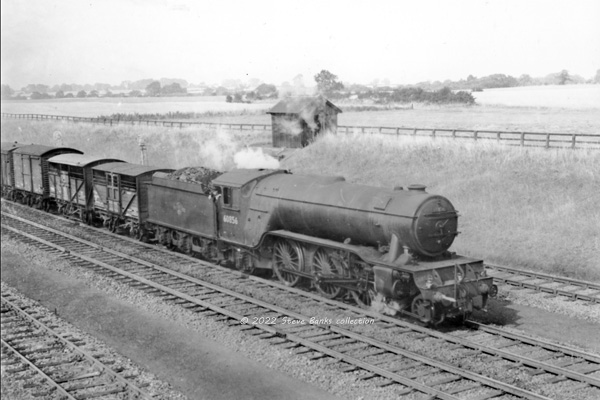
This is a large print but, alas, not very sharp, dated 1959 and showing V2 No 60854 (KX) at Eryholme on the ECML a few miles south of Darlington with a fully fitted express freight. Behind the tender is a pair of cattle wagons:
ex-LMS design ex-GWR/BR
It's hard to tell but they don't appear to be loaded. Photo: Author's collection.
Click on the image for an enlargement
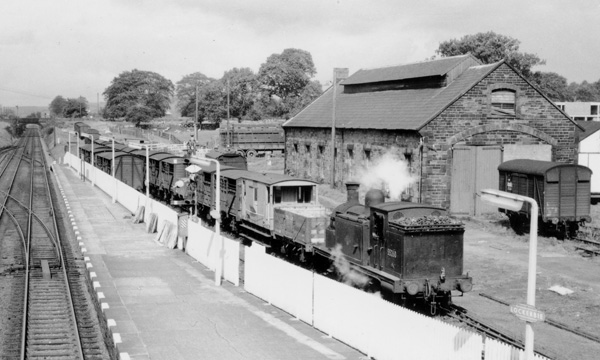
This picture from c1960 speaks volumes. It's at Lockerbie where a cattle market operates to this day. Ex-Caledonian Railway 0-4-4T No 55260 is shunting the yard and presenting cattle trucks to the cattle dock, against which a cattle lorry is parked. Note what looks like a paddock by the cattle pens. Around 16 cattle trucks can be seen of which the nearer ones show ex-LMS and ex-SR lineage, although as mentioned above, both types were built by BR.
Click on the image for an enlargement
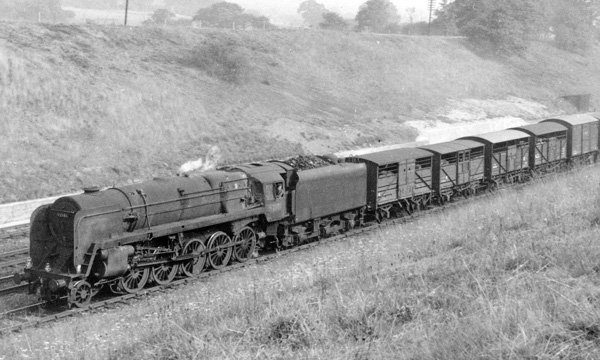
It's 1961 and 9F No 92181 has a fully fitted down freight near Potters Bar with four AVB cattle trucks at the head. These are ex-SR, ex-LMS and ex-GWR or BR (with the same caveat about construction in 1949-50). Photo: R.S. Carpenter.
Click on the image for an enlargement


